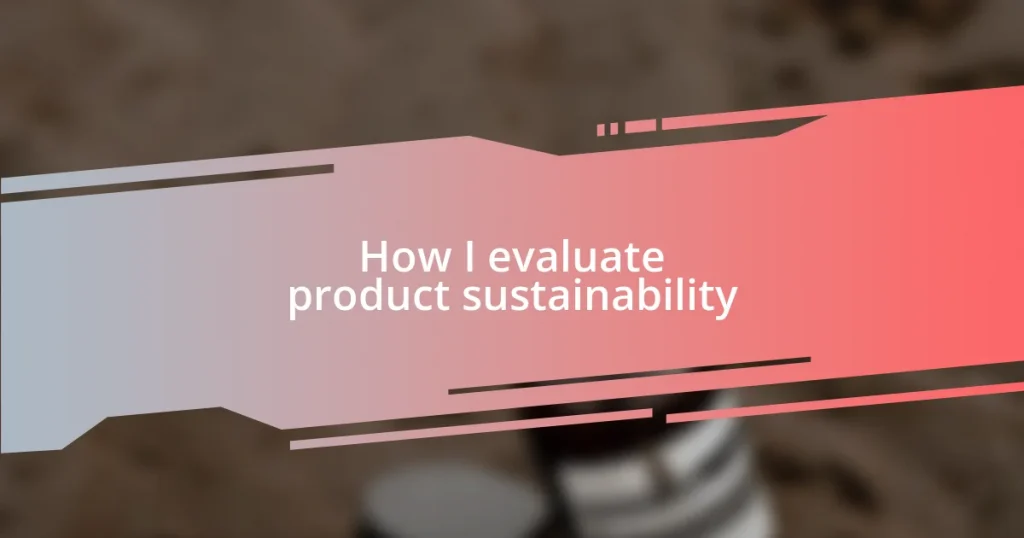Key takeaways:
- Soldering requires a clean and well-prepared workspace, proper temperature control, and the right techniques to ensure strong connections.
- Common mistakes include using too much solder, neglecting surface cleanliness, and overheating components; avoiding these greatly enhances soldering quality.
- Advanced tips such as using flux, adjustable temperature soldering irons, and reinforcing joints with solder wick can significantly improve soldering performance and durability.
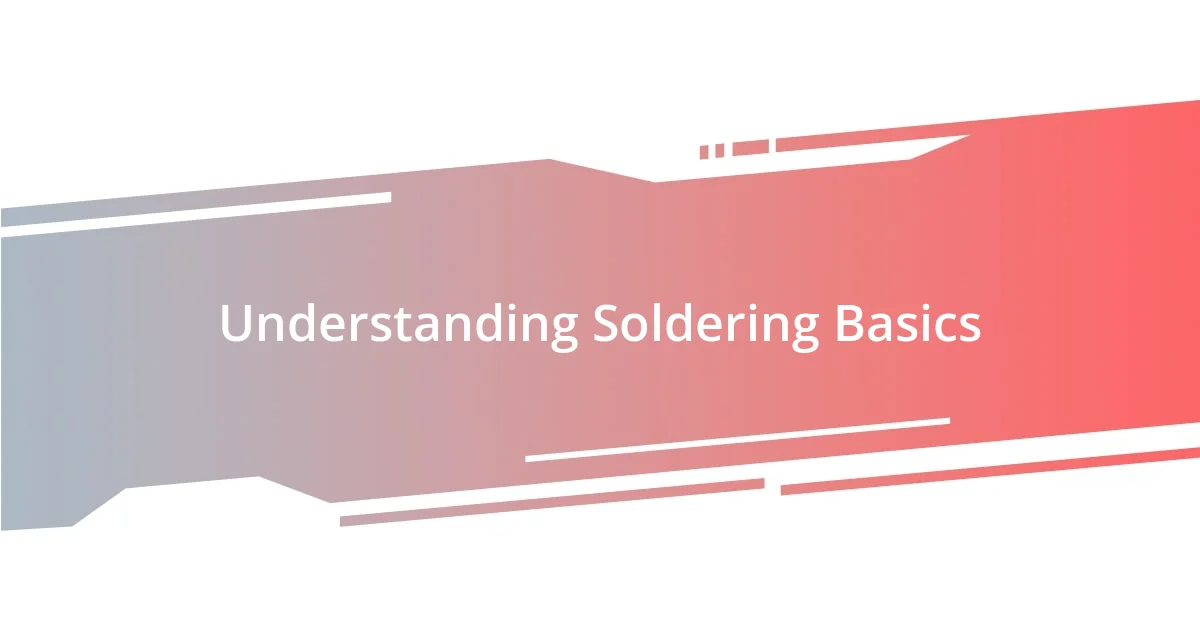
Understanding Soldering Basics
Soldering is essentially the art of joining two pieces of metal using a filler material, which is the solder itself. I remember the first time I held a soldering iron—my heart raced a bit because I was so eager to make my first connection. It was a learning curve; I quickly discovered how essential it is to control the temperature of the iron, as overheating can ruin both the solder and the components.
The most common type of solder is a blend of tin and lead, though lead-free alternatives have become popular due to health and environmental concerns. I once used lead-free solder in a project and noticed it required a slightly different technique. Have you ever experienced that moment when a connection just doesn’t hold? That’s often a result of improper solder composition or technique, underscoring how pivotal it is to choose the right materials and be mindful of your approach.
Preparing the surfaces you’re soldering is crucial—clean, shiny metals are your best friends in this process. I’ll never forget the day I neglected this step and was left with a weak joint. What a disappointment! This reinforced my belief that patience and preparation are just as important as skill when it comes to soldering.
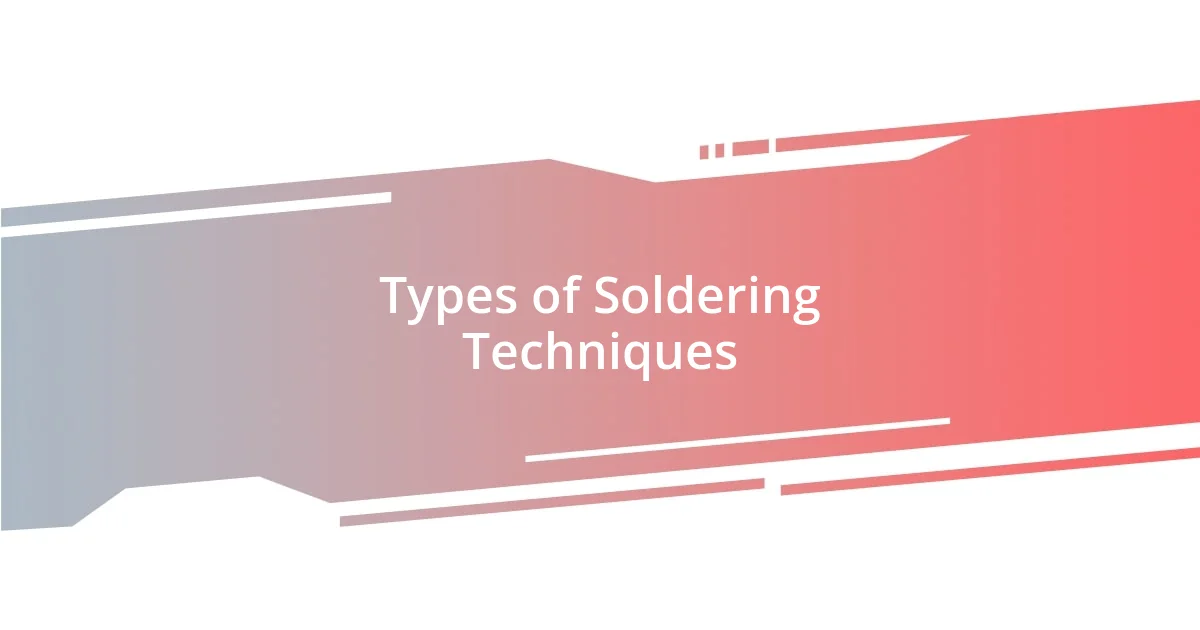
Types of Soldering Techniques
There are several soldering techniques to explore, each with its unique applications and benefits. One of the most popular methods is through-hole soldering, which involves inserting leads of electronic components into holes on a printed circuit board (PCB). I remember tackling my first PCB project and marveling at how satisfying it was to see those leads pop through and know I could secure them with solder. This technique is essential for robust connections, especially in environments where components must endure physical stress.
Surface-mount soldering, on the other hand, has gained popularity in modern electronics due to its efficiency and compact design. I’ve applied this technique in several projects, being amazed at how tiny components can be secured directly to the surface of the board. However, mastering this method takes practice; I still chuckle when I think of the time I accidentally lifted a surface-mount resistor right off the board because my technique wasn’t precise enough.
Then, there’s wave soldering, primarily used in mass production. I find it fascinating how this technique employs a wave of molten solder to connect components on a PCB. It’s a bit of a different world—very different from the hands-on methods I usually prefer. Watching the machines at work during a factory tour gave me a new appreciation for the scale and efficiency that wave soldering brings to manufacturing processes.
| Type of Soldering | Description |
|---|---|
| Through-Hole Soldering | Involves inserting component leads into holes on a PCB for strong connections. |
| Surface-Mount Soldering | Secures components directly to the surface of a board, allowing for compact designs. |
| Wave Soldering | Uses a wave of molten solder for mass production of PCBs. |
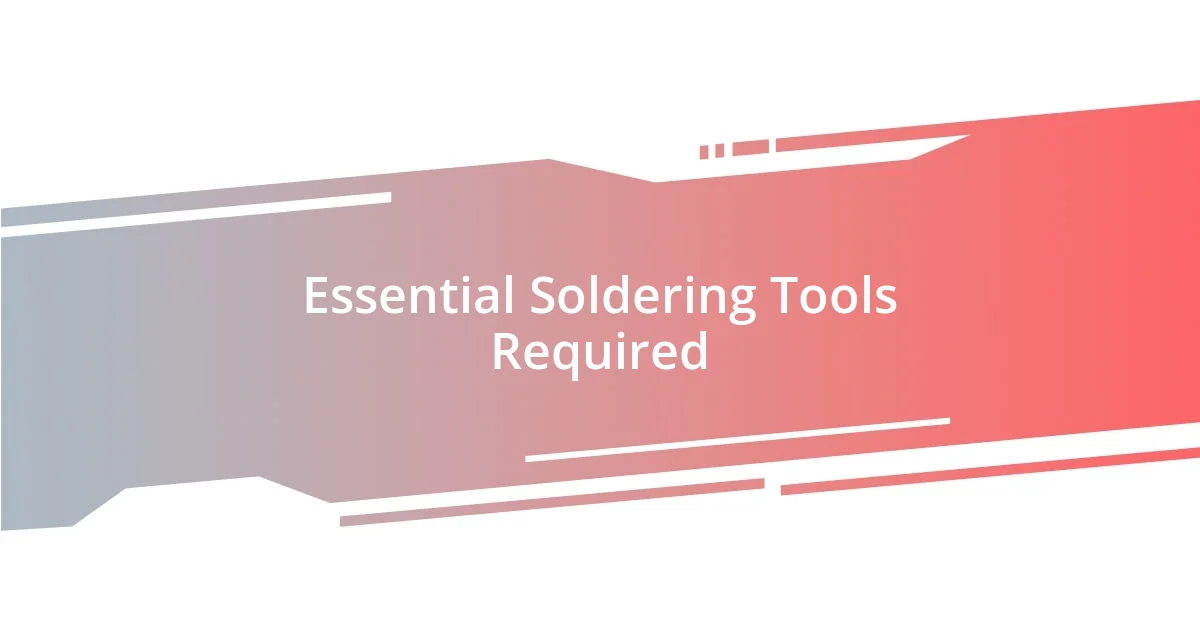
Essential Soldering Tools Required
When it comes to soldering, having the right tools is absolutely essential. I still remember the thrill of unpacking my first soldering kit—each tool felt like a key to unlock creativity and precision. The right tools not only make the job easier but can also enhance the quality of your work significantly. It’s like upgrading from a standard brush to a fine-tipped artist’s brush; the difference in the outcome is astounding.
Here’s a list of the essential tools I believe every aspiring soldering enthusiast should have:
- Soldering Iron: A reliable soldering iron is the heart of any soldering setup.
- Solder: Choose the right type—whether leaded or lead-free—based on your project needs.
- Soldering Iron Stand: This is crucial for safety, keeping your workspace tidy and your iron secure.
- Wire Cutters: Essential for trimming excess leads after soldering.
- Rosin Core Solder Wire: A vital ingredient for promoting good connections.
- Tweezers: Great for holding small components steady during the soldering process.
- Safety Goggles: Protect your eyes; it’s better to be safe than sorry.
- Soldering Flux: This improves the flow of solder, ensuring a strong joint.
Having the right tools at your fingertips can really elevate your soldering experience. I’ve lost count of the times I fumbled with components that were just too small or delicate, and a good pair of tweezers would have made all the difference. Sometimes, it’s these little investments that lead to major improvements in your projects.

Preparing the Work Area Effectively
Creating an effective work area for soldering is crucial to achieving good results. I still recall my early days, where my workbench was cluttered with tools and components, making it nearly impossible to focus. By clearing my space of unnecessary items and organizing my tools—like placing my soldering iron within easy reach—I found that my concentration improved dramatically. Isn’t it interesting how a tidy workspace can directly impact our performance?
Lighting is another key aspect I learned to prioritize. During one late-night project, I struggled to see the tiny details on a circuit board because my workspace was poorly lit. The frustration grew as I fumbled with my soldering iron, and I quickly realized that investing in a bright, adjustable lamp was a game-changer. Proper lighting not only helps in precision tasks but also makes the entire process much more enjoyable and less stressful.
Additionally, I can’t stress enough the importance of temperature control in your soldering area. I remember the dread of discovering that my workspace was too cold, which affected the flow of solder and led to frustrating cold joints. Since then, I always ensure my work area is at a comfortable temperature, which has transformed my soldering experience. It’s those little details that make a big difference!
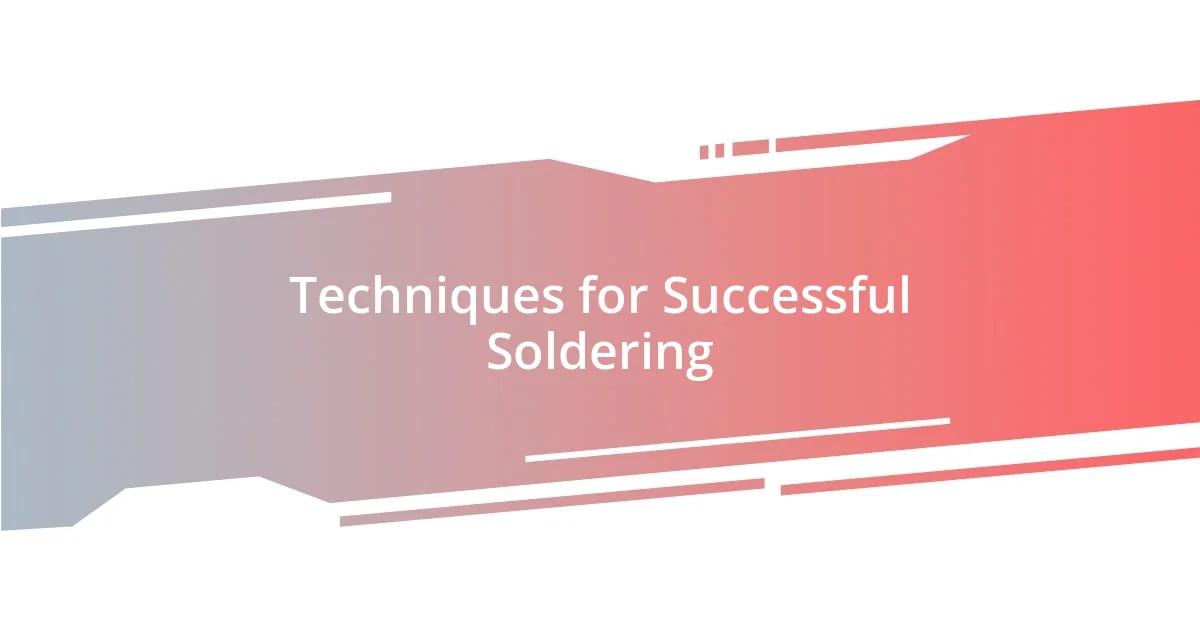
Techniques for Successful Soldering
Techniques for successful soldering hinge on a few key practices that can truly elevate your work. For instance, while working on a complex circuit board, I learned the importance of heating the components and the board before applying solder. This strategy wasn’t just an arbitrary step; it allowed the solder to flow beautifully and create strong, lasting connections, a detail I wish I had known sooner.
Another essential technique I discovered is the angle at which I hold the soldering iron. Initially, I wielded it like a novice, leading to awkward and inconsistent joints. However, once I made the conscious decision to keep the iron at about a 45-degree angle, it completely changed everything. Have you ever experienced that “aha!” moment when everything just clicks into place? This adjustment increased not only my accuracy but also my confidence.
Lastly, patience is my steadfast companion during soldering. I vividly remember rushing through a project, eager to see the final product, only to end up with a mess of cold solder joints. It was a frustrating setback that taught me to slow down and give each joint the time and attention it deserved. Now, I take a moment to inspect each connection before moving on, and I can just feel the difference in the overall quality of my work! Isn’t it fascinating how a little mindfulness can transform a task?
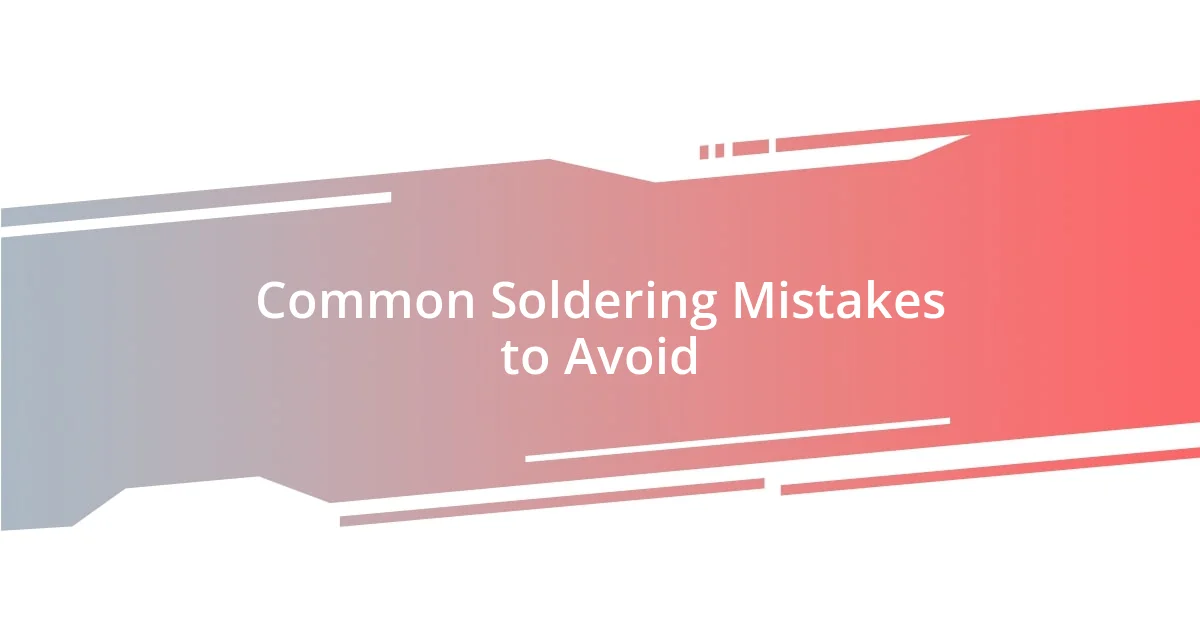
Common Soldering Mistakes to Avoid
When it comes to soldering, one of the most common mistakes is using too much solder. I still remember the first time I piled it on, thinking more had to be better. Instead, I ended up with a messy, gloppy connection that had little strength. It took me time to realize that a small, well-placed amount creates a much cleaner joint. Have you ever had that “ah-ha” moment when simplicity turns out to be the answer?
Another mistake I made early on was neglecting the importance of properly cleaning the surfaces before soldering. I recall a certain project where I was frustrated by constant solder failures, not realizing that the residue left on the components was creating a barrier. Once I started cleaning my surfaces meticulously, I saw a dramatic improvement. It’s surprising how many issues can stem from a little oversight, isn’t it?
Lastly, overheating components is a pitfall I learned to avoid after ruining a few components in my enthusiasm. I clearly remember a delicate chip I fried because I lost track of time during soldering. That incident taught me the importance of speed and control. Now, I make it a point to monitor my time closely, ensuring each connection gets just the right amount of heat without compromising the integrity of the component. Don’t you find it interesting how a single moment of patience can save a project from disaster?
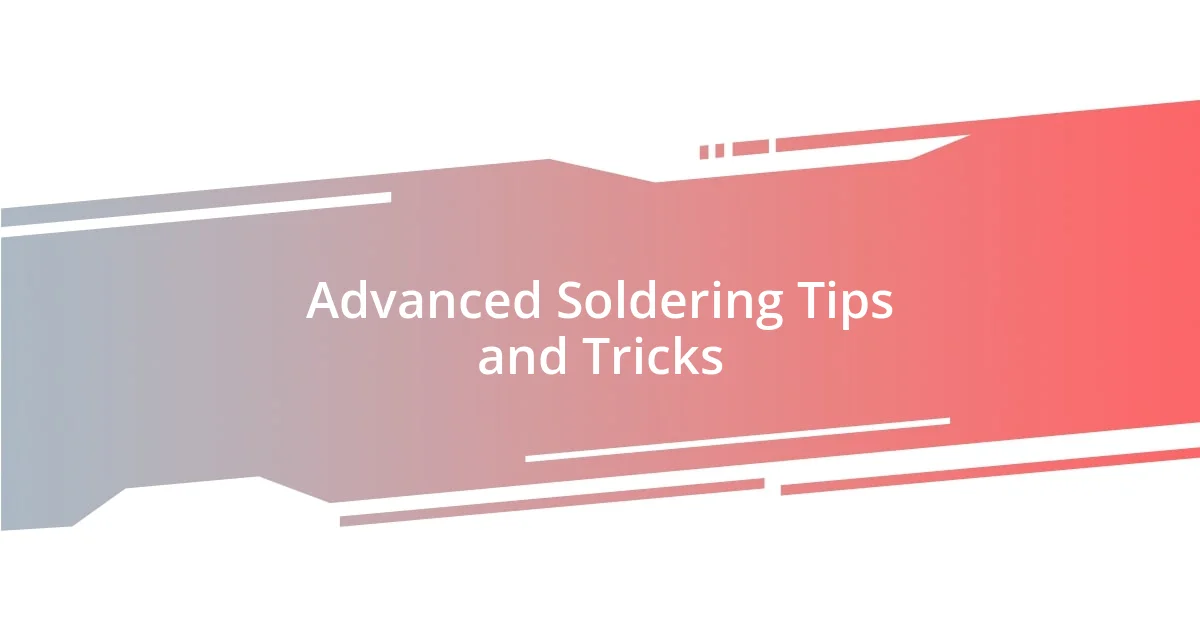
Advanced Soldering Tips and Tricks
As I delved deeper into soldering, I realized the importance of using flux. Initially, I dismissed it as an unnecessary step, believing that a good soldering technique alone was enough. But let me tell you, applying a little flux to the joint before soldering really helped improve the flow and adhesion. I still recall the joy I felt after seeing my solder joints shine perfectly – it was a striking reminder of how the right tools and techniques can elevate my work.
One tip I’ve found invaluable is to use a good-quality soldering iron with adjustable temperature settings. I remember my first soldering iron was a one-temperature-fits-all model, and I struggled with overheating and underheating my connections. Once I switched to a variable temperature iron, I found it much easier to control the heat according to the specific components I was working with. Have you ever thought about how much your tools can affect your results? The difference was astonishing; it allowed me to work with precision and significantly increased the quality of my projects.
Another trick that I now swear by is reinforcing joints with some solder wick. I was once caught off guard when a joint failed after just a few days of use, and it turned out that I hadn’t used enough solder to begin with. After integrating solder wick into my process, I found that it provided the extra strength I needed. Each joint feels more solid, as if I’ve wrapped it in confidence. Don’t you think it’s fascinating how small adjustments can lead to such impactful results?













